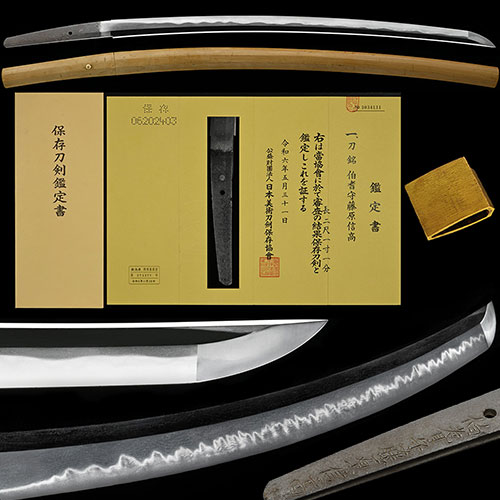
信高 刀 Nobutaka Katana
No.182980伯耆守藤原信高 慶長頃 互の目丁子華やかに乱れ金筋砂流し掛り匂口明るく冴える優品 弍尺一寸一分Houkinokami Fujiwara Nobutaka, Around Keicho period, Gunome-Chouji gorgeous Midare, Kinsuji and Sunagashi-kakari, Nioikuchi is bright and clear, Excellent quality 64.0cm
ご成約Sold
- 裏銘Ura-mei
- 伯耆守藤原信高伯耆守藤原信高 Houkinokami Fujiwara Nobutaka
- 登録証Registration
- 新潟県 Niigata 令和5年11月28日 11/28/5(Reiwa)
- 時代Period
- 江戸初期慶長頃Early Edo period around Keicho period
- 法量Size
-
刃長 64.0cm (弍尺一寸一分) 反り 1.6cm
元幅 3.1cm 先幅 2.2cm 元重 0.75cm 鎬厚 0.85cm 先重 0.58cm 鋒長 4.8cm 茎長 18.2cm 重量 755gHachou 64.0cm (弍尺一寸一分) Sori 1.6cm
Moto-Haba 3.1cm Saki-Haba 2.2cm Moto-Kasane 0.75cm Shinogi-Thikess 0.85cm Saki-Kasane 0.58cm Kissaki-Chou 4.8cm Nakago-Chou 18.2cm Weight 755g - 国Country
- 美濃Mino
- 姿Shape
- 鎬造、庵棟、身幅広く、反りやや深く、中鋒延びる。Shinogidukuri, Iorimune, Wide Mihaba, Slightly deep Sori, Chu-Kissaki extended.
- 鍛Kitae
- 板目肌つみ、流れ肌交じり、地沸微塵につく。Itamehada-tsumi, Mixed Nagarehada, Jinie entered finely.
- 刃文Hamon
- 直ぐ調に焼き出し、互の目に、丁子刃交じり、棟焼き掛り、足・葉頻りに入り、沸よくつき、金筋・沸筋・砂流し頻りに掛り、匂口明るく冴える。Sugu-style Yakidashi, Gunome, Mixed Choujiba, Muneyaki-kakari, There are frequently Ashi and You, Nie entered well, Kinsuji, Niesuji and Sunagashi hangs over and over, Nioikuchi is bright and clear.
- 帽子Boushi
- 直ぐに小丸、深く返る。Suguni-Komaru, Fukaku-Kaeru(Deep Return)
- 茎Nakago
- 生ぶ、先刃上り栗尻、鑢目筋交化粧、目釘孔二内一埋。Ubu, Sakiba-Agari-Kurijiri, Yasurime-sujikai-kesyou, Mekugiana one of the two is filled.
- ハバキHabaki
- 金色絵一重。Single Kiniroe (Single layer of gold painting.)
- 説明Drscription
- 初代信高は、美濃三阿弥派の刀工で、名を河村左衛門といい、美濃に生まれ、天正九年頃に伯耆守を受領、慶長初年には尾張清州に移り、慶長15年には名古屋に住し鍛刀している。寛永13年没。信高家は、その後代々幕末まで尾張鍛冶として活躍した。この刀は、反りやや深く鋒が延びる慶長新刀の姿で、流れ肌交じりの板目肌に地沸が厚くつき、互の目に、丁子を交え、華やかに乱れ、棟焼き掛り、足・葉頻りに入り、小沸よくつき、金筋沸筋砂流し頻りに掛り、匂口明るく冴えた優品である。The first Nobutaka was a swordsmith of the Mino Sanami school, named Kawamura Saemon, who received the title of Hoki no Kami in his native Mino around 1581. In the early years of the Keicho era, he moved to Kiyosu in Owari, and in 1610 he lived in Nagoya, where he forged swords.
He passed away in 1636. The Nobutaka family continued to be active as swordsmiths in Owari until the end of the Edo period.
This sword has slightly deep Sori. It has the appearance of a Keicho Shinto with Kissaki extended. Mixed Nagarehada, Itamehada entered thick Jinie, Gunome, Mixed Chouji, Gorgeous Midare, Muneyaki-kakari, There are Ashi and You frequently, Small-Nie entered well, Kinsuji, Niesuji and Sunagashi hangs over and over, Nioikuchi is bright and clear, Excellent quality.


